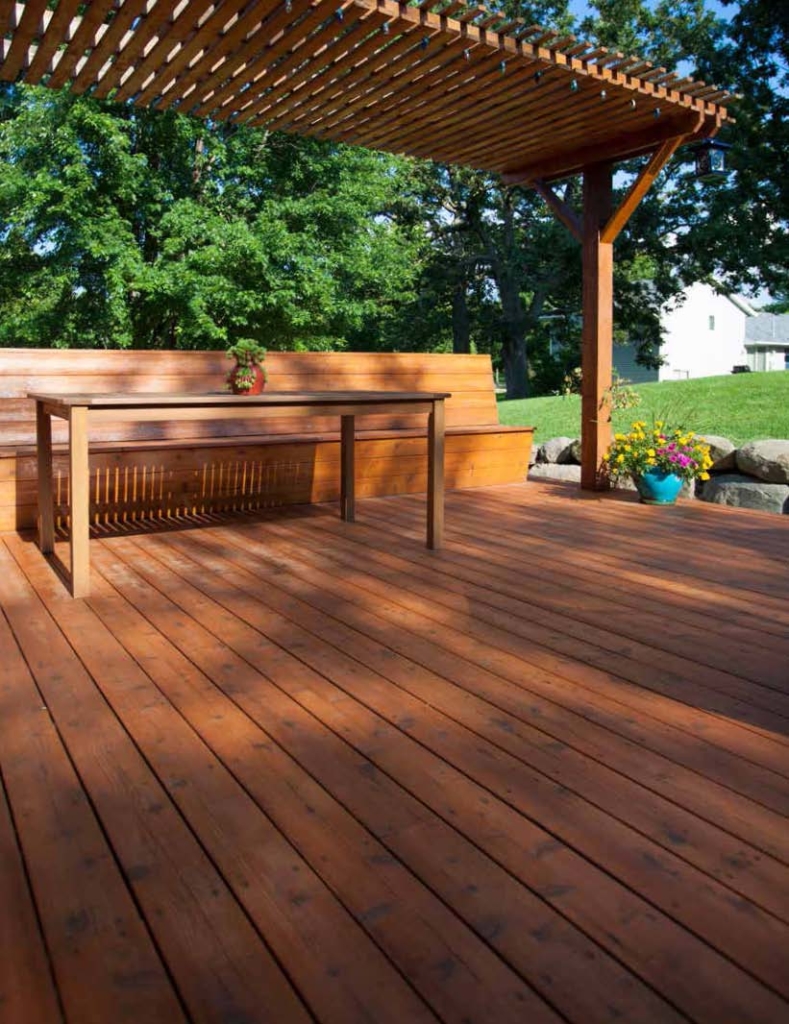Pros offer prep tips to take on new and old decks
 Applying stain or paint to a deck still involves the same age-old painter’s axiom: the finished product relies heavily on the prep work. With decks, however, there’s less margin for error than, say, an interior wall. Even the best stains tend to only offer a couple of years of protection, and with inadequate prep or poor coating quality, flaking can start in only a few short months. Here, three painting professionals specializing in deck work share their insights on how they prep to stain a deck or for a paint job.
Applying stain or paint to a deck still involves the same age-old painter’s axiom: the finished product relies heavily on the prep work. With decks, however, there’s less margin for error than, say, an interior wall. Even the best stains tend to only offer a couple of years of protection, and with inadequate prep or poor coating quality, flaking can start in only a few short months. Here, three painting professionals specializing in deck work share their insights on how they prep to stain a deck or for a paint job.
NEW DECKS, OLD DECKS AND SETTING CUSTOMER EXPECTATIONS
Every deck poses its own unique set of challenges. Some may be old and have gone years without a restain or repaint. Others may have mold or mildew issues, while some may even be newer—a year or two old—but may have been left uncoated for too long or a poor product may have been used as a first coat.
Aaron Andrews, owner of Aaron’s Deck Staining in Nebraska, has had his share of encounters with homeowners who opted to stain a new deck themselves and used a cheap water-based stain.
“Once it flakes up, you have to strip it all off,” he said. “There’s a lot more maintenance and prep work after the deck is stained with a water-based semi-transparent stain. An oil-based stain saves you so much headache down the road, and it’s easier to maintain.”
When Andrews and other deck pros interviewed for this article walk a job, asking questions about the age of the structure, the last time it was stained or painted, and gauging the customer’s understanding of the condition of their deck are top of mind.
For Caleb Roth, owner of Tennessee-based Stain & Seal Experts, explaining why he uses his own proprietary cleaner, brightener and stain formulas is an important part of those early conversations. “The biggest thing is being able to explain to customers the processes we have in place for cleaning and staining,” he said.
“Make them aware of what they’re really looking at,” added Dan Brady, owner of Dan Brady Painting & Wood Restoration in Traverse City, MI. “A maple or oak they see in the store will probably look darker on the deck because it’s more weathered and porous. The biggest thing, I think, is setting customer expectations.”
SAND IT RIGHT FOR BEST RESULTS
Every pro brings a slightly different approach to deck prep. Climate and surface type can factor into decisions and, for Brady, sanding plays a big role in his prep process most of the time.
“I like to say that finishing decks is a lot like working on a hardwood floor,” he added. If the deck is dirty or has mold and mildew, Brady pressure washes the surface first, but he also says a rough grit sandpaper can clean up some dirt or staining. He’ll sometimes use a 40-grit sandpaper instead of a chemical stripper to remove an old coating or grime. In this case, it’s important to gauge whether the sander can effectively clean the surface without gumming up the sandpaper, which can lead to closing the wood’s pores.
“There’s nothing like a sanded deck, but if it’s too dirty, it will definitely start to gum up,” he noted.
If a surface needs a stripper or cleaner first, after washing it off, Brady then turns to an 80- or 60-grit sandpaper to establish a nice surface profile that is ready to absorb the stain.
Like Roth and Andrews, Brady recommends oil-based stains for his customers; and if a deck is in really bad shape and hasn’t been restained for some time, he’ll recommend a solid-color stain.
“The semi-transparent stain is just not going to look the best, even after you sand it,” he said, while adding that good sanding is even more critical in these situations. That’s because a solid-color paint rests on the wood’s surface, whereas a stain wicks into it, he explained. Proper sanding opens the wood pores and gives the stain an opportunity to bond well to the surface.
A LOW-VOC, SOLVENT-FREE APPROACH
Disappointed by product failures when he first started working on decks, Roth hired a chemist and set out to create his own solvent and carcinogen-free stains, cleaners, strippers and brighteners.
Today, Roth works strictly with his own uniquely formulated stains and prep solutions. The prep products work so well, he says, that sanding is minimized—often unnecessary—saving time on the job and increasing profitability.
Roth’s team simply sprays on his company’s cleaner and allows the solution to soak into the deck for 10 to 15 minutes. Following that with a low-pressure wash usually removes all the stains, dirt and grime, he says. He then applies his brightener, which works to shed any left-over cleaner and neutralizes the pH of the wood. If there is an old coating that needs to be removed, he uses his own liquid stripping product before applying the brightener.
“That brightener really opens the pores up and takes the wood back to its original color,” he added.
PAYING ATTENTION TO MILL GLAZE
In Nebraska, Andrews commonly sees decks built either with cedar or pressure-treated pine. The cedar wood has a mill glaze on it, which must be removed before a stain can be applied.
“If you do not remove mill glaze, what happens is, it will look blotchy and the stain won’t adhere. Then, as you walk on it, you’re basically removing stain with your feet,” he explained.
Andrews uses sodium percarbonate mixed with water, which he applies with a sprayer. The solution loosens the mill glaze within 10 to 15 minutes, allowing him to pressure wash the cleaner and the glaze off. After that, he uses an oxalic acid wood brightener.
“It lightens the color of the wood to give the stain better color and really opens up the wood’s grain to allow the stain to soak deeper into it,” he said.
He’ll still use the sodium percarbonate cleaner on pine wood as well, and a stripper if there’s an old coating to remove. Allowing 48 to 72 hours to dry is key, he adds, and then he uses a 40- or 60-grit sandpaper to remove any white oxidized patches. Before staining, Andrews also looks for a moisture meter reading below 15%.
A LOOK AT COMPOSITES
When working with composite decks, all three pros prefer to take on cleaning instead of refinishing jobs. Older composite decks were made with fibers that allowed for recoating, Brady said, but these materials can be difficult to work with, so he prefers to take on cleaning jobs with new materials instead, which is similar to washing off vinyl siding.
Some customers have cleaned the newer composites with bleach, Roth has also found, which can harm the color. “You really just want to use a gentle cleaner,” he said.
“With composites, I refer to the manufacturer’s recommendations,” Andrews added. “Some allow you to use Dawn dish soap and water.”
A PERFECT FINISH STARTS WITH THE RIGHT PREP
No matter what part of the country you live in, wood deck prep comes down to two fundamental needs: a clean surface and open wood pores that can accept the appropriate coating for the job. Each pro may have slightly different techniques or products for achieving those goals, but all agree these two elements are critical for anyone prepping a deck for either stain or paint.




